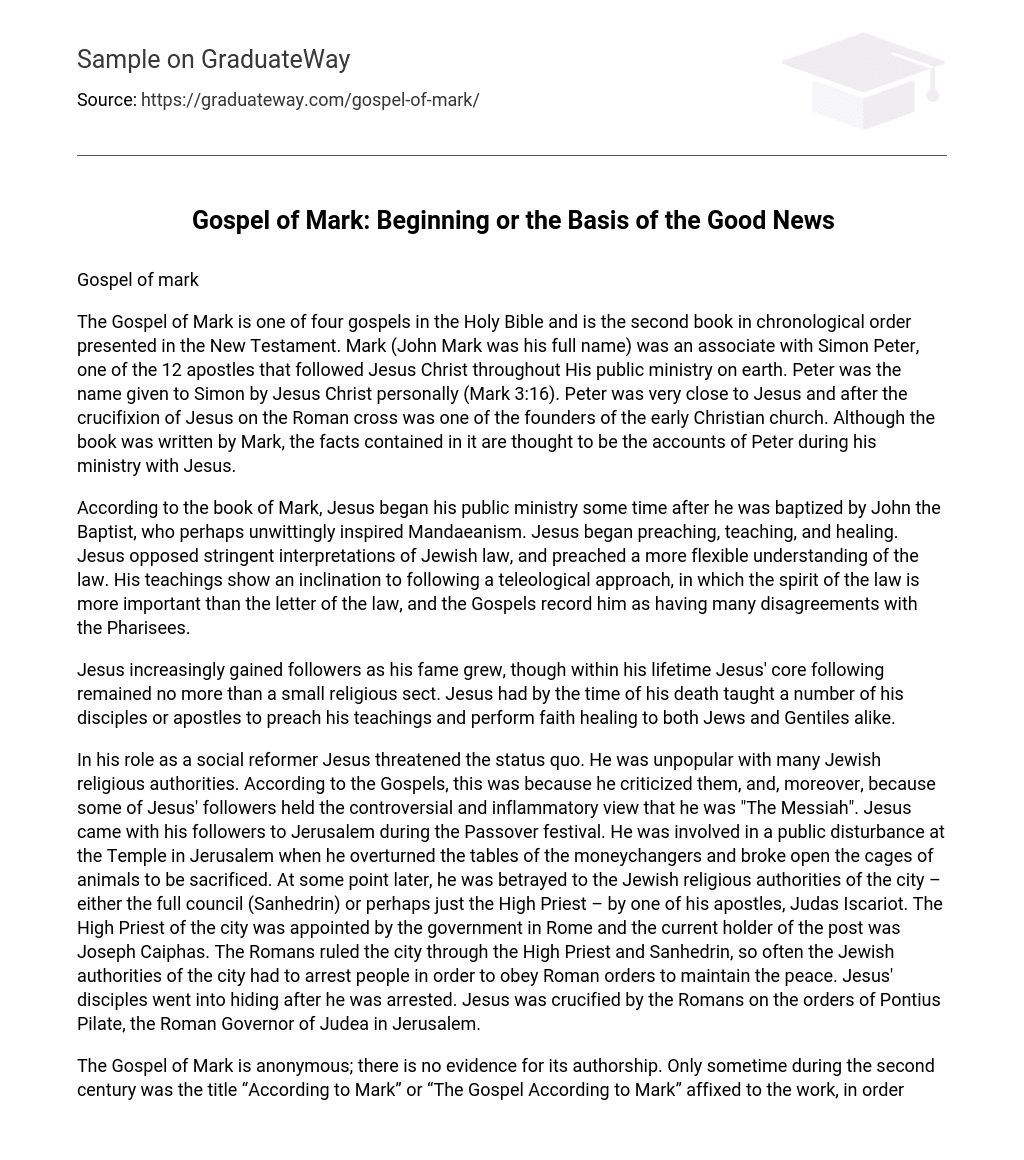Gospel of mark
The Gospel of Mark is one of four gospels in the Holy Bible and is the second book in chronological order presented in the New Testament. Mark (John Mark was his full name) was an associate with Simon Peter, one of the 12 apostles that followed Jesus Christ throughout His public ministry on earth. Peter was the name given to Simon by Jesus Christ personally (Mark 3:16). Peter was very close to Jesus and after the crucifixion of Jesus on the Roman cross was one of the founders of the early Christian church. Although the book was written by Mark, the facts contained in it are thought to be the accounts of Peter during his ministry with Jesus.
According to the book of Mark, Jesus began his public ministry some time after he was baptized by John the Baptist, who perhaps unwittingly inspired Mandaeanism. Jesus began preaching, teaching, and healing. Jesus opposed stringent interpretations of Jewish law, and preached a more flexible understanding of the law. His teachings show an inclination to following a teleological approach, in which the spirit of the law is more important than the letter of the law, and the Gospels record him as having many disagreements with the Pharisees.
Jesus increasingly gained followers as his fame grew, though within his lifetime Jesus’ core following remained no more than a small religious sect. Jesus had by the time of his death taught a number of his disciples or apostles to preach his teachings and perform faith healing to both Jews and Gentiles alike.
In his role as a social reformer Jesus threatened the status quo. He was unpopular with many Jewish religious authorities. According to the Gospels, this was because he criticized them, and, moreover, because some of Jesus’ followers held the controversial and inflammatory view that he was “The Messiah”. Jesus came with his followers to Jerusalem during the Passover festival. He was involved in a public disturbance at the Temple in Jerusalem when he overturned the tables of the moneychangers and broke open the cages of animals to be sacrificed. At some point later, he was betrayed to the Jewish religious authorities of the city – either the full council (Sanhedrin) or perhaps just the High Priest – by one of his apostles, Judas Iscariot. The High Priest of the city was appointed by the government in Rome and the current holder of the post was Joseph Caiphas. The Romans ruled the city through the High Priest and Sanhedrin, so often the Jewish authorities of the city had to arrest people in order to obey Roman orders to maintain the peace. Jesus’ disciples went into hiding after he was arrested. Jesus was crucified by the Romans on the orders of Pontius Pilate, the Roman Governor of Judea in Jerusalem.
The Gospel of Mark is anonymous; there is no evidence for its authorship. Only sometime during the second century was the title “According to Mark” or “The Gospel According to Mark” affixed to the work, in order to distinguish it from the other gospels, which in itself counts as external evidence that Mark wrote it. In spite of the evidence, however, most New Testament scholars are reluctant to identify the author of the Gospel of Mark as (John) Mark and to trace its contents to the apostle Peter. Any other possibility is preferable to this, or so it seems. Thus, the testimony of the early church, no matter how early, is discounted as mere speculation. It should be noted, however, that, if it were inventing authors for apologetic reasons to under gird the authority of the gospels against detractors, the early church would surely have given the Gospel of Mark a direct apostolic origin.
There is disagreement about whether Mark wrote his gospel before or after Peter’s death, which took place during Nero’s persecution of the church c. 65. The Gospel of Mark was written either when Peter was in Rome or just after his death in Rome. To be on the safe side a date ranging from 63-68 should be attributed the Gospel of Mark.
Mark’s purpose in writing the gospel is to explain to his Christian hearers/readers the beginning or the basis of the good news that they believed. He aims to give more information about Jesus, the focus of the proclamation of the early church. The Roman Christians believed the good news consisting of Jesus Christ, but needed to know more about the life, death and resurrection of the one in whom they believed, the arche of the gospel of Jesus Christ. From the contents of the gospel itself, he stresses Jesus’ passion and resurrection, but also includes many accounts of Jesus’ healings, exorcisms, controversies and some teaching. Mark does not intend, however, to provide a completely chronological account, as already indicated. Furthermore, Mark’s purpose seems to have been to preserve Peter’s eyewitness testimony and depository of traditions about Jesus for the Roman church.
REFERENCE :
Drane ,John. 2001. Introducing the new testament. Minneapolis : Fortress press .
Henderson, Suzanne Watts. 2006. Christology and discipleship in the Gospel of
Mark. Cambridge UK: Cambridge University Press.





